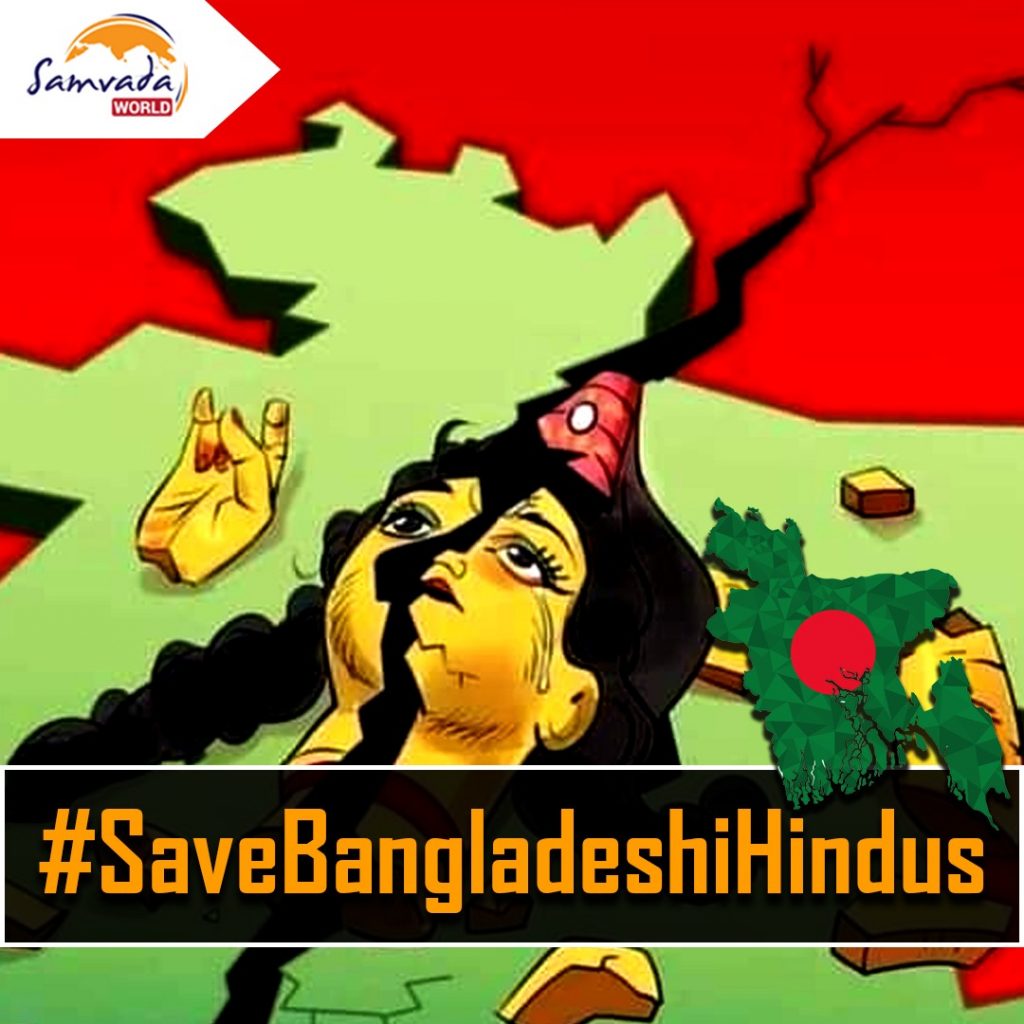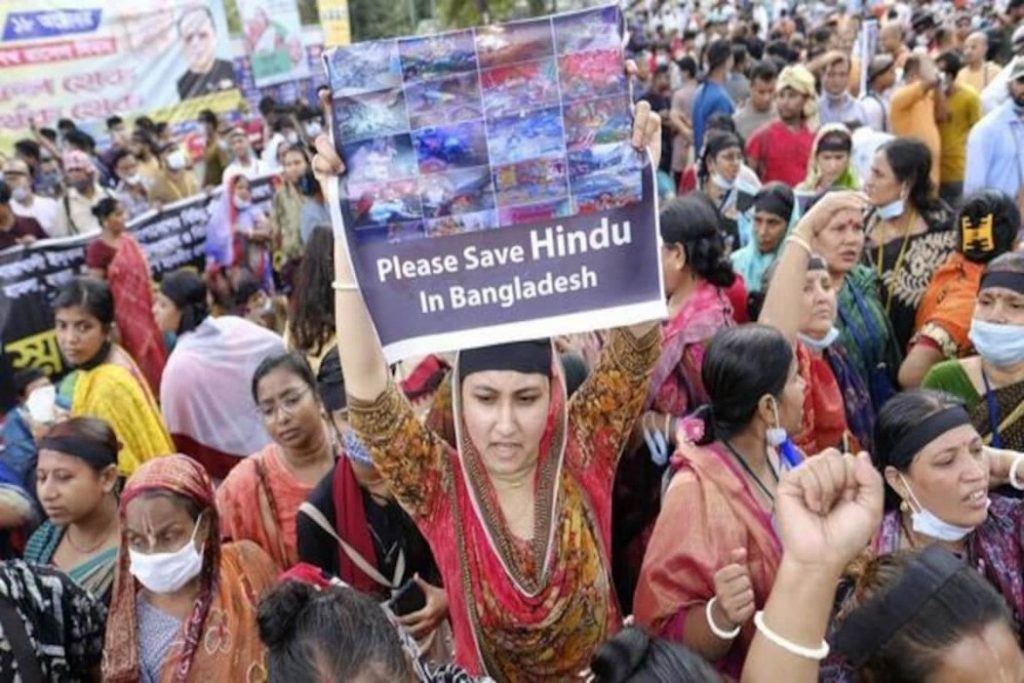
- Formal demographic studies alone may not be able to provide accurate estimates.
- Contemporary social dynamics and population displacements are two important accelerators that contribute to changes in population composition.
- The planting of the Quran was an excuse to target, assault, kill and scare Hindus to displace them away from their native place.
- It was a plot to get rid of non-Muslims from Bangladesh and to fasten change in its demography. The spread of the riots across districts had a similar pattern.
Demographic trends in light of Indian population statistics available from census data between 1950-2010 is a contemporary topic of discussion in the media. Typically, birth and death rates, and fertility rates are considered while projecting futuristic population composition. However, formal demographic studies alone may not be able to provide accurate estimates. Contemporary social dynamics and population displacements are two important accelerators that contribute to changes in population composition. Both these factors are not explicitly discussed in social demographic studies. This article provides an account of recent happenings in Bangladesh and recognizes the impact of such incidents on population composition.
During the Navaratri celebrations, Hindus were attacked by Muslim mobs. Attacks were widespread, across districts, and continued for five days. The mobs that attacked Hindus were peaceful protests turned invariably violent. The protests were organized against alleged desecration of Quran in one of the community Durga puja locations. In that incident, two muslims found a copy of Quran at the feet of Hanuman idol and that was considered as desecration of Quran. The violent mobs were led, in most instances, by politicians and Mosque leaders including Imams.
In the violence, hundreds of community Durga puja locations were vandalized. Idols were broken and disrespected. Few devotees were killed and Hindus in hundreds were injured. Hundreds of homes and shops belonging to the Hindus were ransacked, looted and burnt. Hindus were assaulted, women were raped. Standing crops of Hindus in rural areas were burnt.
Investigation found that Muslims were involved in placing the Quran at the feet of Lord Hanuman. Leaders of a local Mosque were conspirators of this incident.
There were hundreds and in some instances thousands of Muslims in the protesting crowds. During the protests, they pelted stones, attacked police and initiated violence. The pattern of violence at Cumila was repeated in Hajigund at Chandapura, Dhaka, areas of Noakhali, Rangpur, Chittagond and other places across Bangladesh.
The Bangladesh government was under pressure to identify the perpetrators of violence. After a few days of investigation, it was found that Muslims were involved in placing the Quran at the feet of Lord Hanuman. Leaders of a local Mosque were conspirators of this incident. Many Muslim leaders, qualified in Islamic scriptures, were found to be involved in the rioting.
Iqbal Hossain was identified by the police, after analysing video footages of the CCTV cameras installed at the Durga Puja venue of Cumila, as the person who planted a dark-green colored Quran at the feet of Hanuman idol and walked away with club of Lord Hanuman. Hafez Humayun and Faisal, two caretakers of the Mosque of the Durgabari Mazar area, had provided logistics and conspired the Quran desecration plot. They had selected the Durga puja venue at the banks of Nanua Dighi (Lake) in the city of Cumilla. The lake is surrounded by Hindu families, who have been observing Durga Puja and creating such pandals for the past 20 years. Iqbal Hossain was also responsible for creating a facebook post depicting alleged desecration of Quran by Hindus.
The family members of Hossain claim that he was mentally unstable. The Quran was given to him by Fayez. The Quran was not printed in Bangladesh but was brought from Saudi Arabia by Fayez. Fayez returned to Bangladesh from Saudi Arabia a year ago and set up a mobile service shop in Comilla. The Quran was his personal copy. On the day of the incident, he brought the people of the area to the pandal of Durga Puja. Another associate of Fayez, Ekram called up the emergency services numbers 999 to inform the police that a Quran was found in the Puja area.

Those who desecrated the Quran were all Muslims and some of them were qualified in Islamic religious studies. They managed the plot and created allegations against Hindus. It was an excuse to target, assault, kill and scare Hindus to displace them away from their native place. It was a plot to get rid of non-Muslims from Bangladesh and to fasten change in its demography. The spread of the riots across districts had a similar pattern.
In riots related to Kishoreganj district, police arrested four people including an Imam. Kali Mandir in Kadim Maijhati area of Kishoreganj district was vandalised by miscreants after illegally entering the temple. Rashid (25), an Imam, led the attack and Mamunur Rashid(22), two teenagers aged 15 and 16 and Kafil Uddin, a 50-year-old village doctor assisted him.
Intelligence and investigative agencies point to a strong possibility that rabid Islamists of Bangladesh have collaborated with the Taliban and IS operatives from various parts of the world to orchestrate this communal violence. The objectives could include eradication of non-Muslim population, strengthening Umma, embarrassing the Sheikh Hasina government, enrolling Indian Muslims for Jihad, and straining excellent bilateral relations between India and Bangladesh.
Intelligence and investigative agencies point to a strong possibility that rabid Islamists of Bangladesh have collaborated with the Taliban and IS operatives from various parts of the world to orchestrate this communal violence
In Bangladesh, around 1.3 crore Hindus live along with a handful of Buddhists and Christians. Hindu population is about 8 percent of the population. Before Partition, Hindus had constituted nearly 30 percent, according to the 1941 Census. Among Hindus, a small number live in the cities and pursue professions like Law and Medicine, while the majority live in the countryside and are usually artisans, fishermen or peasants. Durga Puja is the principal festival of Bengali Hindus. Over 13,000 community Durga Pujas are held in Bangladesh according to 2019 statistics.
Public Durga Puja is supported by the general public. But, in recent years, Jamaat-e-Islami and Hefazat-e-Islam and other similar minded organizations are threatening Durga Puja committees and are forcefully shutting down puja at many venues. The Government of Bangladesh has failed in the last 20 years to bring the perpetrators and hooligans to face justice. Islamists are enjoying immunity causing insecurity among Hindus and other minorities.
(Author is a media analyst focusing on current affairs)
=====================
References:
1: Nothing New in Persecution of Hindus in Bangladesh. But This Time, We are Talking about It Firmly https://www.msn.com/en-in/news/opinion/nothing-new-in-persecution-of-hindus-in-bangladesh-but-this-time-we-are-talking-about-it-firmly/ar-AAPEOae?ocid=BingNewsSearch
